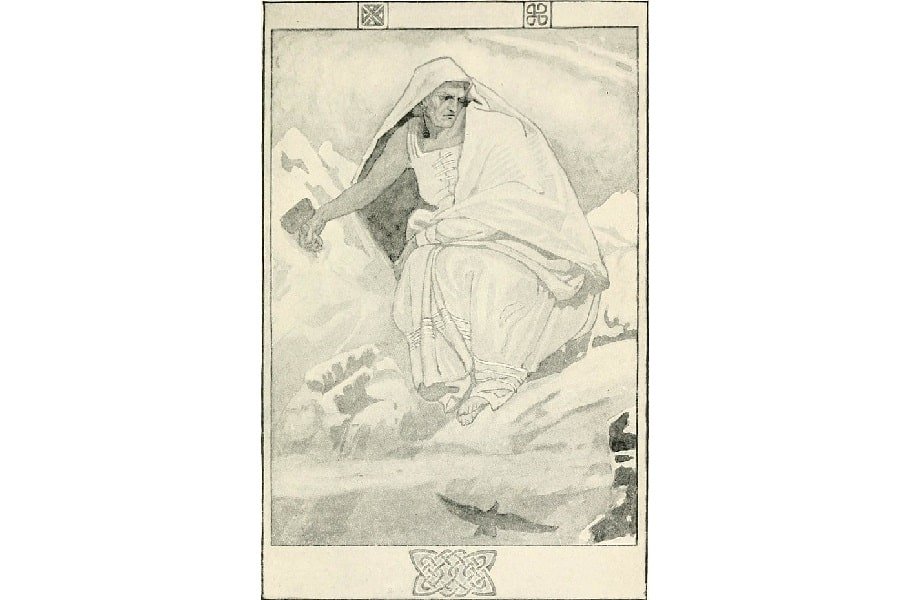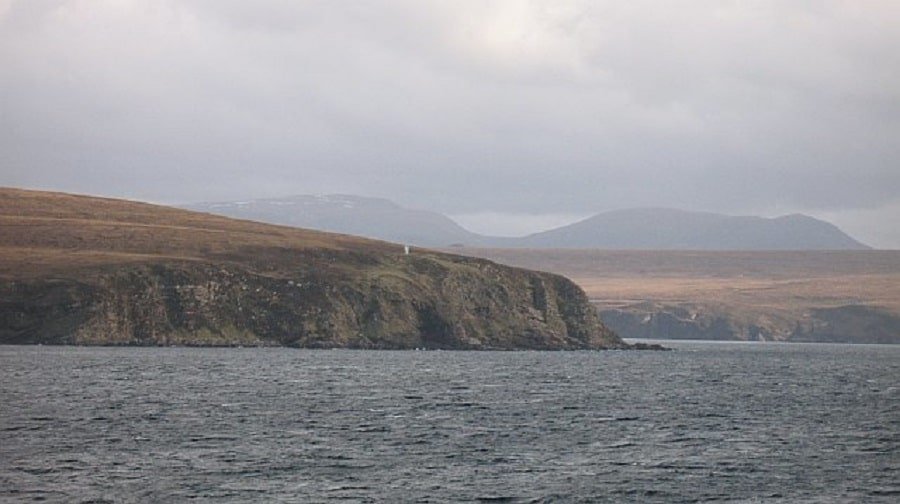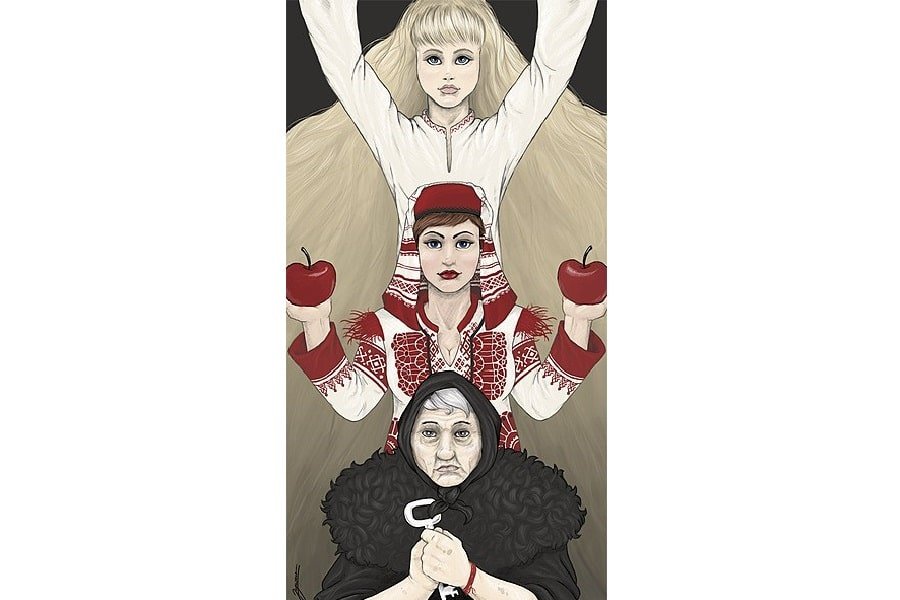Cailleach, also known as the Cailleach Bhéara or the Hag of Beara is a crone-like figure of the Celtic world. Cailleach, whose name literally translates to ‘old woman,’ is a divine hag in Celtic mythology, associated with Scotland, Ireland, and the Isle of Man. She is regarded as the goddess of the winds, wilderness, and winter.
Table of Contents
What Does Cailleach Mean?

The word Cailleach comes from the Gaelic language, spoken in Ireland, Scotland, and the Isle of Man. The name comes from the Old Gaelic word Cailech, meaning veiled one. In Irish, Cailleach is referred to as Cailleach Bhéara which translates to shrill or sharp, linking the mythical figure to the winter and horned animals.
Whether the veiled figure is called the Veiled One, Queen of Winter, or Hag of Beara, the Celtic goddess‘s name has become synonymous with the changing of seasons and the strength of nature.
Who is Cailleach?
Cailleach is a figure woven into Gaelic culture, although the worship of the figure pre-dates the Celts. She is a winter goddess found within Celtic mythology. In particular, she is mostly associated with Ireland, Scotland, and the Isle of Man. The Cailleach is ancient and is perhaps the most tremendous figure in the Celtic world.
The ancient giantess is often referred to as the Hag of Winter or the Veiled One. In the Scottish context, the goddess is referred to as Berea, Queen of Winter. In the Isle of Man, she is known as Caillagh ny Groamagh, which translates to the sullen old woman. The goddess was said to dwell in rugged, remote mountain caves.
In Scottish and Irish mythology, the old woman is associated not only with storm winds, wild places, and winter but also with the landscape. The powerful crone was believed to have created the many hills and mountains in Scotland and Ireland.

Is Cailleach a Witch?
Although Cailleach is often associated with sorcery and witchcraft, she is not a witch in the traditional sense. In case you are wondering what a traditional witch is, think wielder of magic, brewer of potions with the ability to cast spells on unsuspecting victims.
The crone is a wise woman, who could be described as a witch figure in mythology. She possesses a magical staff, and while she is associated with the supernatural, and witchcraft, her abilities and powers are more closely tied to the natural world.
The goddess is often seen as a force of nature, and as the patron of animals rather than the practice of witchcraft. To some, the ancient crone is a wise woman, as it is believed that with great age, comes wisdom. To others, she was believed to be not only wise but a fortune teller too.
She is so revered in Gaelic mythology not only as the personification of the fiercest aspects of mother nature but also because elders, in Gaelic culture, were highly regarded and respected.
In the later tales that make up Scottish folklore, the wise woman becomes known as the Cailleach nan Crauchan or the witch of Ben Cruachan.
Is Cailleach a Triple Goddess?
In Irish tradition, Cailleach was considered to be a triple goddess, with Cailleach Bheur and Cailleach Corca Dhuibhne. The triple goddess is a common concept in many cultures. The concept of the triple goddess is that the three aspects of the goddess correspond to the three stages of a woman’s life; maiden, mother, and crone.
It is important to note that the goddess of winter is not universally seen as a triple goddess, and her role varies depending on the specific cultural and mythological context.
In some interpretations, Cailleach is seen as embodying all three aspects of the triple goddess. She is associated with the maiden, who signifies youth and new beginnings, the mother as a symbol of fertility and creation, and the crone, as a symbol of wisdom and transformation.
In other interpretations, Cailleach appears as the crone. In these interpretations, she is an old and powerful figure who is associated with wisdom, transformation, and the cycle of life and death.

What Does Cailleach Look Like?
According to Irish and Gaelic mythology, Cailleach or Cailleach Bheur appears as an old hag of great age, who is frightful to behold. The giantess is described as having long, wild hair, with one eye in the center of her forehead.
The hag’s face is wrinkled and weathered, she has red teeth, and either blue or extremely pale skin. The ancient goddess is usually described as being veiled, wearing a clock adorned with skulls carrying a magical staff.
Myths That Feature Cailleach
The Cailleach is mentioned in many stories, all of them passed down through generations in the form of oral traditions. Some believe that Cailleach was a title given to several different entities and has been linked to several figures in mythology.
The title has been applied to Birog who was the fairy woman that saved the Celtic Warrior god, Lugh when he was an infant.
It is believed the old Irish poem titled “The Lament of the Old Woman of Beara” is about the crone goddess. The poem is believed to have been written in the ninth or tenth century.
In the poem, Cailleach, given the name Digde, had seven periods of youth, each one directly following the previous period. During that time each man the Cailleach lived with grew old, eventually dying of old age. In the tale, the goddess also had fifty foster children.
The Role of Cailleach in Mythology
Cailleach is a prominent figure in Celtic and Gaelic mythology who is most commonly associated with the changing seasons and the creation of landscapes. She is the personification of winter.
In many myths, Cailleach is portrayed as a powerful, fearsome ancestor who possessed the ability to create storms and wreak havoc. The winter goddess was immortal and therefore ageless but still appeared as an old woman. In Scotland, the mythical figure is believed to be the mother of all other pagan gods and goddesses.
In some stories, she is also associated with fertility, the cycle of life, death, and rebirth. As such, she is considered both a bringer of death and life, a destroyer as well as a creator deity. The divine hag was considered the protector of wild animals and was associated with horned animals such as cattle and deer.
According to legend, the old crone was the one who decided when winter would begin and when it would release its icy grip on the land of the Celts. The old hag was a figure that was neither good nor evil, a figure balanced between light and dark.
According to Scottish myth, Cailleach would appear on Samhain, on the 31st of October, the date we call Halloween. On Samhain, Cailleach would appear in the sky, often riding a giant wolf. Cailleach would tap her magical staff on the ground, causing it to freeze, thus ushering in winter.

Cailleach and the Grain Harvest
Considered both a creator and destroyer, she was also considered to be a protector. Her connection to winter also connected her to grain, a food source necessary for survival during the winter months. The last sheath of grain from the harvest before winter was dedicated to Cailleach.
The farmer who finished the grain harvest would make a corn mother or dolly that represented the blue-skinned crone and would throw it into a neighbor’s field if they had not finished their harvest.
The last farmer to finish the harvest was left in possession of the corn dolly and had to care for it throughout winter until the beginning of the next planting season. No farmer wanted to house the Cailleach for winter and so competition was fierce during the harvest with each farmer trying to make sure they would not be the last to finish.
Cailleach as a Force of Nature
According to Gaelic myth, if February 1st was particularly sunny, Cailleach planned to make winter last longer. February 1st is the Là Fhèill Brìghde or Saint Brigid’s Day, a day of feasting and festivities that mark the beginning of Spring.
According to legend, this day also happened to be the day Cailleach runs out of her store of firewood. Each year the goddess would collect enough firewood to see her through the winter. If the day was particularly bright, it was believed that Cailleach needed the extra day to gather enough firewood for a long, cold winter.
Similar to the beliefs held in Scotland and Ireland, the people of the Isle of Man held similar views about the crone on February 1st. The island’s inhabitants would look to the skies on St. Bridget’s Day on the lookout for a giant bird with sticks in its beak.
On the West coast of Scotland, the residents know that Cailleach will soon bring winter upon them when the roaring of the coming storm can be heard off the coast for three days. The roaring was caused by Cailleach washing her plaid (kilt) in the Gulf of Corryvreckan.
Cailleach and the Landscape
In Scottish folklore, where she is known as the Queen of Winter, Cailleach is responsible for creating the large hills and mountains that cover Scotland. The goddess created these by releasing the boulders she had gathered and carried in wicker baskets (or shirts depending on the myth), onto the land wherever she pleased.
The legends vary on whether the blue hag intentionally created the mountains to act as stepping stones, or if they were created by accident as the stones fell from her basket. In some tales, the old woman was responsible for the creation of the rivers of Scotland and Ireland.
As easily as the hag could create incredible landscapes, she could destroy them. It is believed that Cailleach created many prominent mountains that are often used as landmarks in Ireland and as such, many places are associated with her
The goddess tended to wells, one of which overflowed while the crone slept after a long day of herding deer. The accident created Scotland’s longest lake, Loch Awe situated in Argyll and Bute in the Western Scottish Highlands.

Places Associated with Cailleach
According to Celtic myth, the Cailleach created the Hag’s Head, a formation on the cliffs of Moher in County Clare, Ireland. The Hag of Beara as she is usually referred to in Ireland is associated with the Beara Peninsula in County Cork. Additionally, the goddess of winter and wild places is associated with the Hag’s Chair in County Meath.
In Scotland, the hag is most associated with Argyll and Bute in the western Highlands. It is believed she created the highest mountain in the region, Ben Cruachan. Ben Nevis, the highest peak in Scotland, was believed to be the goddesses’ throne.
What Powers Does Cailleach Have?
The goddesses’ powers were tied to the seasons and as such the weather. Just as she was credited with the creation of the landscape, she was also responsible for its destruction through violent storms.
The old woman was able to ride storms and leap across mountains. Additionally, Cailleach in some traditions was able to shapeshift, taking on the form of a giant bird.
Along with her magical staff, Cailleach possessed a hammer, with which she was able to control thunder and storms (seeing a similarity here to a god of thunder, Thor). It was this ability to control violent storms that made Cailleach a powerful and wild force in Celtic and Gaelic mythology.
Cailleach and the Seasons
After appearing on Samhain riding a giant wolf and tapping her magical staff on the ground, causing it to freeze and marking the beginning of the winter, she would transform herself.
When Cailleach could bear the dark winter months no longer, she would drink from the well of youth. Upon drinking from the well, the old woman would transform into a beautiful younger woman, signaling the beginning of Spring. Winter would end on May 1st, which is known as Bealltainn, the Mayday festival.
The tales vary however on whether or not the goddess transformed into a young woman in springtime. If Cailleach transferred into a young woman, the goddess is the embodiment of both Cailleach and Brìghde or Brigid, who is the goddess of spring.
Other tales have the two nature goddesses as separate, with Cailleach ruling over the period from Samhiam to Bealltainn and Brìghde ruling over the summer months. When Brìghde and Cailleach are not the same goddesses, Cailleach turns to stone discarding her magic staff underneath a horse or holly bush.

Cailleach, the Protector of Animals
In addition to being the hag of winter, creator, and destroyer of landscapes, the goddess was also the protector of animals. According to mythology, Cailleach looked after animals during long dark winter months. During the winter the blue-skinned giantess would herd deer.
Cailleach was believed to be the patron of wolves. According to some Irish myths, Cailleach could take the form of a wolf. Although the crone is linked specifically to wolves and deer, she was said to care for both wild and domestic animals during winter.
Cailleach and Death
The Cailleach is linked to destruction because of the violence of winter winds and storms. In the same vein, the goddess is linked to death in some tales. It is said she gathers the souls of the dead. The one-eyed crone supposedly flies through the skies with the Wild Hunt during the Winter Solstice.
READ MORE: 10 Gods of Death and the Underworld From Around the World
The Wild Hunt can be found in various European mythologies, including Norse mythology. The hunters are supernatural creatures traveling through the land in pursuit of a mythical creature.
READ MORE: Norse Gods and Goddesses: The Deities of Old Norse Mythology
Shrines to Cailleach
The Cailleach was worshiped by the ancient Celts and by those who came before, evidenced by the pre-Celtic megaliths associated with the Cailleach.
READ MORE: Ancient Civilizations Timeline: 16 Oldest Known Cultures From Around The World
The powerful hag was so revered, that there is an ancient stone shrine to Cailleach at a place known as Glen Cailleach, near Glen Lyon in the Scottish Highlands. The shrines take the form of crudely but carefully constructed stone houses called Tigh Nan Cailleach. The stones surrounding the houses represent the powerful hag, her husband Bodach, and their many children.
According to the oral tradition of the locals in the area, the goddess and her family were given shelter in the glen. While the family lived there the ground was fertile and the inhabitants of the glen were prosperous.
When the family left, they gave the locals the stones present at the site today. They promised the inhabitants of the glen that if they put the stones so they were overlooking the glen on Bealltainn (May Day), and placed them back inside the stone shelter on Samhain, the glen would always be fertile.
Shrines to Cailleach in Ireland
In Ireland, it is believed that the Corcu Duibne tribe of the Dingle Peninsula revered Cailleach, known to them as Cailleach Béara, above all others. Cailleach Béara was the tribe’s primary goddess. It was believed (and still is) that the crone lives in the Beara Peninsula.
Because of the belief that Cailleach turns to stone for the warmer months, many standing stones across Ireland are said to be sacred to the old hag. The stones represent the powerful hag, her husband Bodach, and their children.
Today the Cailleach continues to be remembered by those who live in Ireland, Scotland, and the Isle of Man. The wise old crone is commemorated on tea towels and in the tales still told in the mountainous and craggy regions that make up the Celtic world.